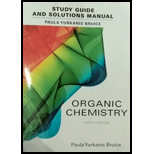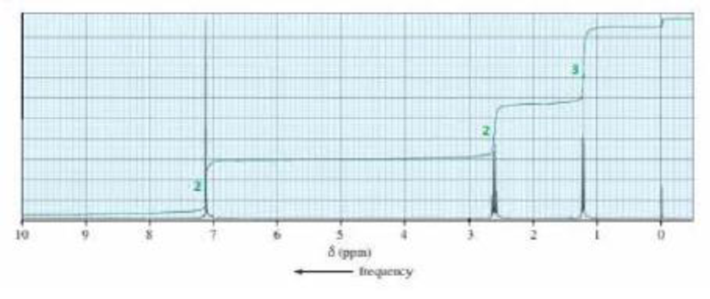
Student's Study Guide and Solutions Manual for Organic Chemistry
8th Edition
ISBN: 9780134066585
Author: Paula Yurkanis Bruice
Publisher: PEARSON
expand_more
expand_more
format_list_bulleted
Concept explainers
Textbook Question
Chapter 18, Problem 97P
An unknown compound reacts with ethyl chloride and aluminum trichloride to form a compound that has the following 1H NMR spectrum. What is the structure of the compound?

Expert Solution & Answer
Want to see the full answer?
Check out a sample textbook solution
Students have asked these similar questions
Metal clusters are present in biocatalysts, enzymes. Explain briefly.
Some metal clusters have photochemical properties. Explain briefly.
Give the mechanism and product for the reaction below. Hint - the product contains
two six membered rings
NaOEt (Base)
C
Chapter 18 Solutions
Student's Study Guide and Solutions Manual for Organic Chemistry
Ch. 18.1 - Draw the structure for each of the following: a....Ch. 18.3 - Why does hydration inactivate FeBr3?Ch. 18.6 - Prob. 4PCh. 18.7 - What is the major product of a Friedel-Crafts...Ch. 18.9 - Describe two ways to prepare each of the following...Ch. 18.10 - Prob. 7PCh. 18.11 - Name the following:Ch. 18.11 - Draw a structure for each of the following: a....Ch. 18.11 - Draw the structure for each of the following: a....Ch. 18.11 - Correct the following incorrect names: a....
Ch. 18.12 - Prob. 14PCh. 18.12 - List the compounds in each set from most reactive...Ch. 18.13 - Prob. 16PCh. 18.13 - What product(s) result from nitration of each of...Ch. 18.13 - Prob. 18PCh. 18.13 - What products are obtained from the reaction of...Ch. 18.15 - Give the products, if any, of each of the...Ch. 18.16 - a. Does a coupling reaction have to be used to...Ch. 18.16 - Show how the following compounds can be...Ch. 18.16 - Prob. 24PCh. 18.17 - What is the major product(s) of each of the...Ch. 18.17 - Prob. 26PCh. 18.18 - Why isn't FeBr3 used as a catalyst in the first...Ch. 18.18 - Prob. 29PCh. 18.18 - Write the sequence of steps required for the...Ch. 18.18 - Show how the following compounds can be...Ch. 18.19 - What product is formed from reaction of...Ch. 18.19 - Prob. 33PCh. 18.19 - Draw the structure of the activated ring and the...Ch. 18.20 - Prob. 35PCh. 18.20 - Prob. 36PCh. 18.20 - Diazomethane can be used to convert a carboxylic...Ch. 18.21 - Prob. 38PCh. 18.21 - Prob. 39PCh. 18.21 - Prob. 40PCh. 18.22 - Prob. 41PCh. 18 - Draw the structure for each of the following: a....Ch. 18 - Name the following:Ch. 18 - Prob. 44PCh. 18 - Prob. 45PCh. 18 - For each of the statements in Column I, choose a...Ch. 18 - What product is obtained from the reaction of...Ch. 18 - Draw the product(s) of each of the following...Ch. 18 - Rank the following substituted anilines from most...Ch. 18 - Prob. 50PCh. 18 - Prob. 51PCh. 18 - Show how the following compounds can be...Ch. 18 - Prob. 53PCh. 18 - The compound with the 1H NMR spectrum shown below...Ch. 18 - Rank each group of compounds from most reactive to...Ch. 18 - Prob. 56PCh. 18 - Prob. 57PCh. 18 - For each of the following components, indicate the...Ch. 18 - Prob. 59PCh. 18 - Prob. 60PCh. 18 - Describe two ways to prepare anisole from benzene.Ch. 18 - Prob. 62PCh. 18 - The following tertiary alkyl bromides undergo an...Ch. 18 - An aromatic hydrocarbon with a molecular formula...Ch. 18 - Show how the following compounds can be...Ch. 18 - Use the four compounds shown below to answer the...Ch. 18 - a. Rank the following esters from most reactive to...Ch. 18 - A mixture of 0.10 mol benzene and 0.10 mol...Ch. 18 - Prob. 69PCh. 18 - Prob. 70PCh. 18 - Benzene underwent a Friedel-Crafts acylation...Ch. 18 - Prob. 72PCh. 18 - Prob. 73PCh. 18 - Friedel-Crafts alkylations can be carried out with...Ch. 18 - Show how the following compounds can be prepared...Ch. 18 - Prob. 76PCh. 18 - Prob. 77PCh. 18 - a. Describe four ways the following reaction can...Ch. 18 - Propose a mechanism for each of the following...Ch. 18 - How can you prepare the following compounds with...Ch. 18 - Describe how naphthalene can he prepared from the...Ch. 18 - Using resonance contributors for the carbocation...Ch. 18 - Prob. 83PCh. 18 - What reagents are required to carry out the...Ch. 18 - Prob. 85PCh. 18 - Prob. 86PCh. 18 - Prob. 87PCh. 18 - Propose a mechanism for each of the following...Ch. 18 - P-Fluoronitrobenzene is more reactive toward...Ch. 18 - When heated with chromic acid, compound A forms...Ch. 18 - Show how the following compounds can be prepared...Ch. 18 - How can you distinguish the following compounds...Ch. 18 - Describe how mescaline can be synthesized from...Ch. 18 - Propose a mechanism for the following reaction...Ch. 18 - Propose a mechanism for each of the following...Ch. 18 - Describe how 3-methyl-1-phenyl-3-pentanol can he...Ch. 18 - An unknown compound reacts with ethyl chloride and...Ch. 18 - a. Explain why the following reaction leads to the...Ch. 18 - Explain why hydroxide ion catalyzes the reaction...Ch. 18 - Prob. 100PCh. 18 - Prob. 101PCh. 18 - a. How can aspirin be synthesized from benzene? b....Ch. 18 - Prob. 103PCh. 18 - Show how Novocain, a painkiller used frequently by...Ch. 18 - Prob. 105PCh. 18 - Saccharin, an artificial sweetener, is about 300...
Knowledge Booster
Learn more about
Need a deep-dive on the concept behind this application? Look no further. Learn more about this topic, chemistry and related others by exploring similar questions and additional content below.Similar questions
- Q1: Draw a valid Lewis structures for the following molecules. Include appropriate charges and lone pair electrons. If there is more than one Lewis structure available, draw the best structure. NH3 Sulfate Boron tetrahydride. C3H8 (linear isomer) OCN NO3 CH3CN SO2Cl2 CH3OH2*arrow_forwardIn the following molecule, indicate the hybridization and shape of the indicated atoms. -z: CH3 CH3 H3C HO: CI: :arrow_forwardQ3: Draw the Lewis structures for nitromethane (CH3NO2) and methyl nitrite (CH3ONO). Draw at least two resonance forms for each. Determine which form for each is the major resonance contributor. Page 1 of 4 Chem 0310 Organic Chemistry 1 Recitations Q4: Draw the Lewis structures for the cyanate ion (OCN) and the fulminate ion (CNO-). Draw all possible resonance structures for each. Determine which form for each is the major resonance contributor.arrow_forward
arrow_back_ios
SEE MORE QUESTIONS
arrow_forward_ios
Recommended textbooks for you

 Organic ChemistryChemistryISBN:9781305580350Author:William H. Brown, Brent L. Iverson, Eric Anslyn, Christopher S. FootePublisher:Cengage Learning
Organic ChemistryChemistryISBN:9781305580350Author:William H. Brown, Brent L. Iverson, Eric Anslyn, Christopher S. FootePublisher:Cengage Learning


Organic Chemistry
Chemistry
ISBN:9781305580350
Author:William H. Brown, Brent L. Iverson, Eric Anslyn, Christopher S. Foote
Publisher:Cengage Learning
NMR Spectroscopy; Author: Professor Dave Explains;https://www.youtube.com/watch?v=SBir5wUS3Bo;License: Standard YouTube License, CC-BY